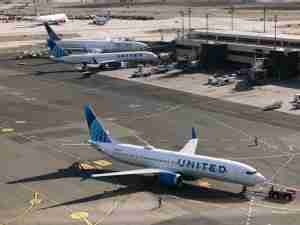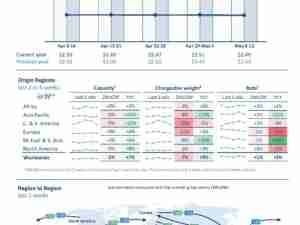Fitch Ratings has taken rating actions on the following airport terminal projects located at New York's John F. Kennedy International Airport:
--Terminal One Group Association LP (TOGA) special facility revenue bonds, issued by the New York Transportation Development Corporation (NYTDC) downgraded to 'BBB+' from 'A-'; Rating Watch Negative;
--JFK International Air Terminal (IAT or Terminal 4) issued by the Port Authority of New York and New Jersey special project 'BBB+' placed on Rating Watch Negative.
Fitch has affirmed the ratings on the following large, international gateway U.S. airports and revised the Rating Outlooks to Negative from Stable:
-- Atlanta, GA Hartsfield-Jackson Atlanta International Airport's (ATL) 'AA-' ratings on both the senior lien airport general revenue bonds issued on behalf of and the airport passenger facility charge (PFC) and subordinate lien general revenue bonds;
--Chicago O'Hare International Airport's (ORD) 'A' rating senior lien revenue bonds and passenger facility charge revenue bonds;
--Dallas-Ft. Worth International Airport's (DFW) (TX) 'A+' rating joint revenue bonds;
--Los Angeles International Airport's (LAX) 'AA' and 'AA-' ratings on the senior lien and subordinate lien revenue bonds, respectively, as well as the 'A' rating to LAX's related payment obligations;
--Metropolitan Washington Metropolitan Washington Airports Authority's (MWAA) 'AA-' rating airport system revenue bonds;
--Port of Seattle's Issuer Default Rating (AA-), senior lien revenue bonds (AA), intermediate lien revenue bonds (AA-), subordinate lien revenue bonds (AA-), passenger facility charge bonds (A+) and limited tax general obligation bonds (AA-);
--San Francisco International Airport's (SFO) 'A+' rating second series revenue bonds.
Fitch has affirmed the rating on the following large U.S. airport and revised the Rating Outlook to Negative from Positive:
--Miami-Dade County, Florida's 'A' rating aviation revenue bonds.
RATING RATIONALE
The recent outbreak of coronavirus and related government containment measures worldwide create an uncertain global environment for air travel in the near term. While the above airport issuers performance data through most recently available issuer data may not have indicated impairment, material changes in revenue and cost profile are occurring across the sector and likely to worsen in the coming weeks and months as economic activity suffers and government restrictions are maintained or expanded. Fitch's ratings are forward-looking in nature, and Fitch will monitor developments in the sector as a result of the virus outbreak as it relates to severity and duration, and incorporate revised base and rating case qualitative and quantitative inputs based on expectations for future performance and assessment of key risks.
Airport Terminal Project Rating Actions
The rating actions to the New York's JFK International Airport terminal projects reflect more acute downside risks under the current COVID19 environment. To date, there have been greater disruptions in the international flights given the government controls on flights between countries as well as significantly falling demand.
Terminal One Group Association (TOGA)
TOGA has been experiencing declining passenger levels since early March and the project debt has weaker structural features as debt repayment is tied to rental payments from its four anchor tenants representing foreign-flag carriers: Air France, Japan Airlines, Korean Air and Lufthansa. Operational liquidity of just $20 million (less than three months of operating costs) is narrower relative to traditional airport credits and the lack of a funded debt service reserve constrains the financial flexibility. Fitch will look to timely actions by management to ensure project revenues remain sufficient to cover project costs, lease rental payments to the Port Authority of New York and New Jersey, and bond debt service. Should receipts from contract carriers and terminal concessions remain depressed, management will need to stabilize revenues by raising charges to the anchor carriers in a timely manner to ensure adequate funding for all project costs. The coronavirus' impact on TOGA's financial and operational profiles highlights the more acute risks associated with this single terminal facility, which are more commensurate with a 'BBB'-category rating. A recovery in traffic combined with prudent management actions to address the current environment may result in a return to a Stable Rating Outlook as the situation continues to evolve.
John F. Kennedy International Arrivals Terminal (IAT)
The IAT facility's primary operating revenues are sourced from a combination of Delta Air Lines (IDR: BBB-/Negative) payments under a cost-recovery rate making framework and charges derived from contracted foreign-flag carriers based on passenger volumes as well as from terminal concessions. Significant levels of flight cutbacks from Delta and other terminal carriers will likely result in declines in terminal project top-line operating revenues and will affect debt service coverage ratio levels until air traffic returns to normal levels. With debt service coverage ratios (DSCRs) of more than 2x in recent fiscal years and a funded debt service reserve, Fitch believes there are low near-term liquidity risks to funding upcoming debt repayment. Fitch will look to timely actions by management to ensure project revenues remain sufficient to cover project costs, lease rental payments to the Port Authority of New York and New Jersey, and bond debt service. A recovery in traffic combined with prudent management actions to address the current environment could result in a return to a Stable Rating Outlook as the situation continues to evolve.
International Gateway Airport Rating Actions
The Negative Rating Outlook actions assigned to the above international gateway airport credits reflects the current stressed environment in aviation, affecting international and domestic travel. Severe declines in enplaned passenger traffic will affect operating revenues across all of these airports, with the greatest impacts to occur in the second quarter of 2020 and potentially extend into future periods due to the coronavirus pandemic. These airports have strong franchise positions as essential gateway and hub facilities, but still operate with a moderate to high level of dependence on international air travel from both domestic and foreign-flag carriers. In the near term, Fitch has assessed that for each of the airports above, the unrestricted cash reserves alone are sufficient to meet debt service due through the end of the current calendar year.
The drop in air travel is likely to be steeper than what was seen during prior global event episodes such as SARS and the Sept. 11 terrorist attacks, and the start of the recovery period is difficult to assess as the virus spread is still growing in regions where air travel is most prevalent. Conditions are constantly changing given the fast moving nature of events, and U.S. airports are facing significant reductions in passenger traffic under this environment.
Fitch expects the dramatic reduction in air travel levels to increase financial pressure on all U.S. airports at varying levels, a sector that has had a decade long stretch of traffic expansion and financial stability. The unprecedented requests in recent days for assistance from the federal government by both the air carriers and the airports are indicative of the mutual strains suffered in the aviation industry and demonstrate a clear signal of the present financial pressures. Robust liquidity across most airports, evident through a combination of cash funded bond reserves and additional accounts with unencumbered funds, should provide additional protection to cover upcoming bond payments and is viewed as a mitigating consideration.
Fitch also expects airport management to initiate a number of self-protective actions to preserve their fiscal postures although there are limitations given the broad impairment to the general economy and the industries tied to the aviation sector. Airline agreements in most cases are structured to provide mechanisms to revise airline payment levels in case of large variances to budgeted performance; however, the airlines themselves are financially constrained to the point this approach is not anticipated. Further analysis will follow in the weeks to come with detailed analyses of management reactions and responses, as well as incoming data on traffic, revenues and expense control actions. In the longer-term, Fitch will analyze traffic and revenue impacts caused by possible changes in air travel patterns.
Fitch conducted a rating case and a sensitivity case to the above credits to assess coverage and liquidity. The rating case scenario, which contemplates airport enplanement declines of approximately 35% in calendar year 2020 relative to 2019 actual levels based on the following assumptions of quarterly traffic activity: Q1 2020 (-15% domestic and international), Q2 2020 (-60% domestic and -80% international); Q3 2020 (-40% domestic and -50% international) and Q4 2020 (-20% domestic and -25% international). For calendar years 2021 and 2022, Fitch assumes 95% and 100% recoveries relative to 2019 levels. Recognizing there are different fiscal year periods for each airport, the assumed traffic levels will be accordingly adjusted. A more severe sensitivity case assumes traffic declines continue at the same peak traffic loss of Q2 2020 for an additional quarterly period followed by recoveries that are similar to the rating case. The results of these scenarios will be published as a Ratings Scorecard.









